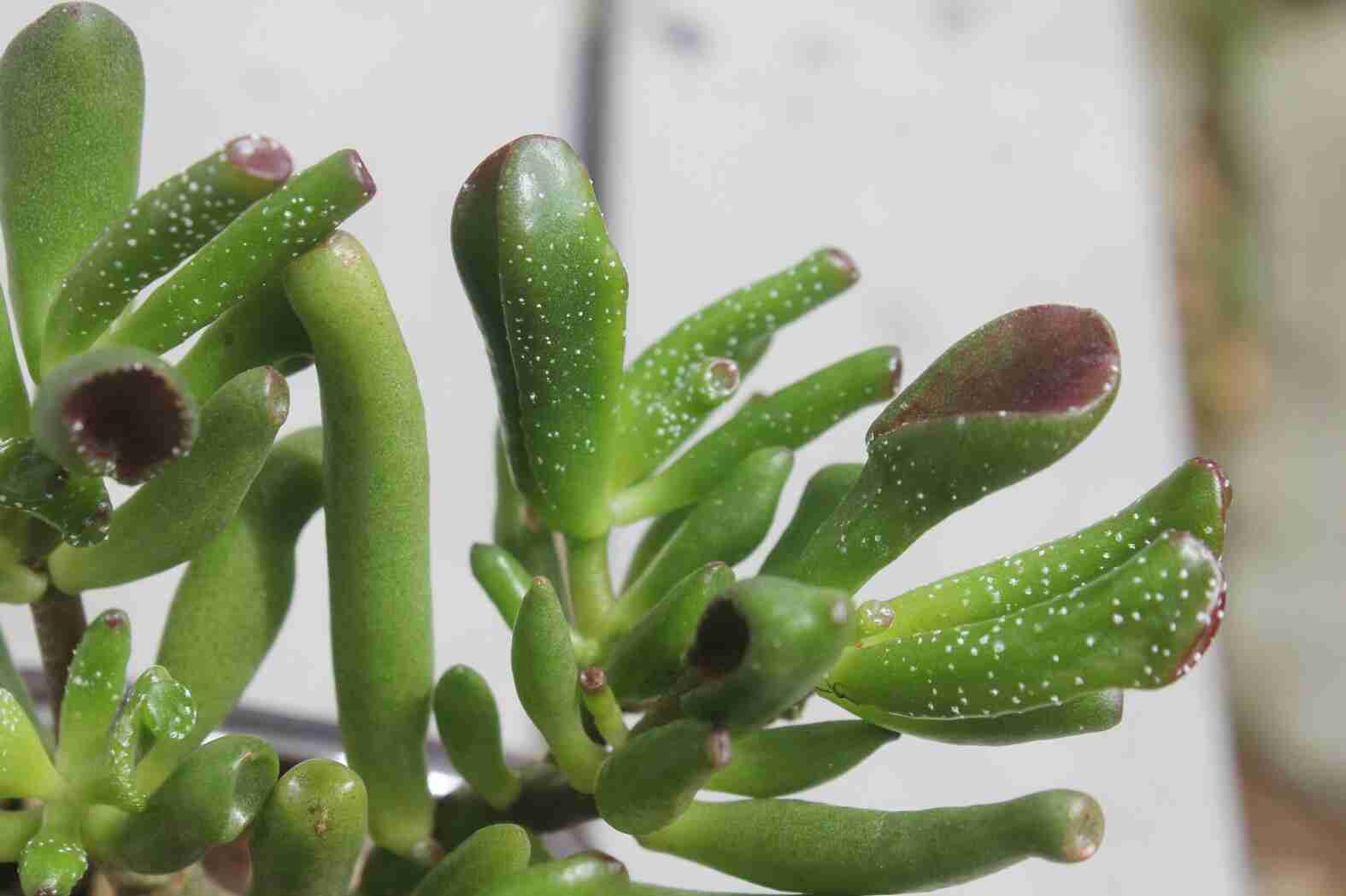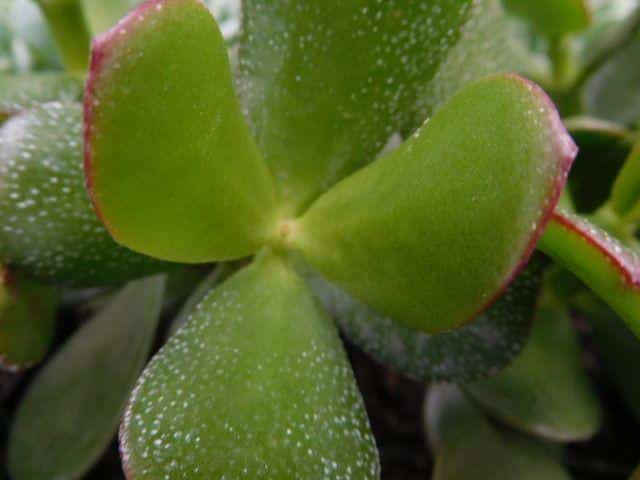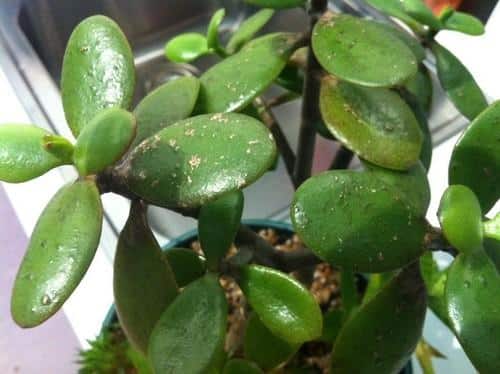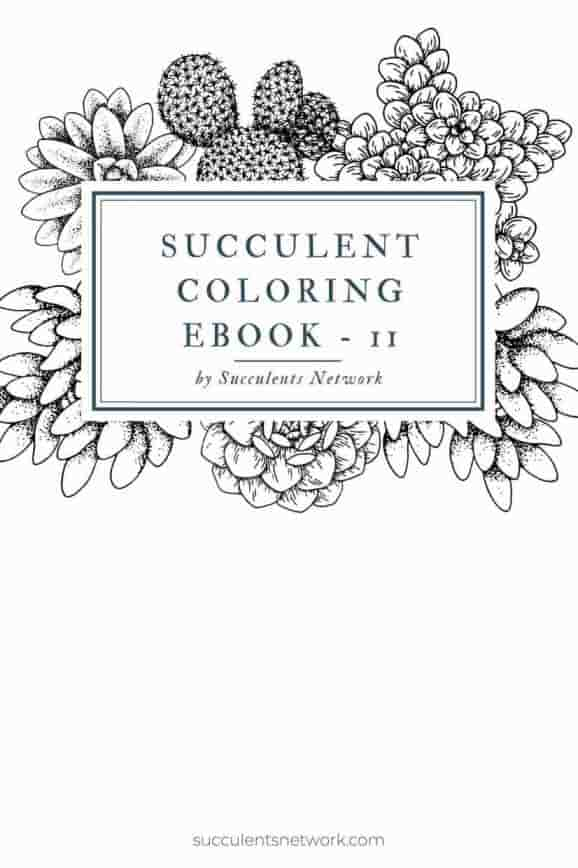Taking care of plants involves various issues. You must water your plants and make sure that they are growing healthily. You should also monitor them regularly to notice any changes so that you diagnose the plant before it’s late if there is a need to. You might ask yourself a lot of questions trying to figure out what causes white spots on jade plant. There are various things that might cause those white spots.

Picture via succulentsireland
What Causes White Spots On Jade?
White spots on the jade plant might be a result of various issues. Naturally, jade leaves may develop white spots. Fungal disease, excess salts, powdery mildew might also cause white spots on the leaves of your plant.
1. Excess salt
Jade plant stores more water in leaves. When you are watering your plants they take water through the roots and evaporation takes place through the leaves. Water contains various nutrients and they may have salt. When evaporation takes place; some salt residue remains on the leaf. The white spots can be taken care of easily by wiping them off with a moist towel to restore the shiny image of the leaves.
2. Powdery Mildew
Most plants can be affected by a fungal disease called powdery mildew. White spots on jade plants can be a result of powdery mildew fungal disease. This fungal disease forms the white spots on the plant during the winter season due to cooler temperatures and excessive humidity. During winter, sunshine is limited and light is also low. As a result; plants receive improper circulation. The watered plants go for a longer time being moist without receiving light and sunlight which results in fungal spores. These conditions breed the powdery mildew fungal disease. The remedy for powdery mildew will be discussed in detail in the later paragraphs.
3. Insects
Jade rarely gets affected by insects. However, there are mealy bugs insects that might find comfort on the jade leaves. Mealybugs’ insects are whitish in color which resembles cotton. If your jade plant is indoors, you should be careful whenever you put it outside. It might be affected by those insects.

Picture via Sucsforyou
4. Oedema
This is a condition caused by the excess of water in the plant. It happens when the roots take up more water faster causing imbalances as the plant fails to use all the water in the plant. The excess water may cause rapture of cells in the leaves which may appear as blisters; thereby forming white spots on the leaves.
5. Spider Mites On Jade Plants
Spider mites can also cause the white spots on jade. Spider mites are red in color and can hide in the soil.

Picture via garden
Other Reasons For White Spots On My Jade
There are other less common insects that might cause white spots on the plant. Damaged leaves of the plant can attract various insects that might find accommodation in those flakes. Thrips and aphids insects can breed on the jade leaves and cause white spots.
Powdery Mildew Remedy For Jade Plants
If you are pretty sure that the white spots on your plant are caused by the powdery mildew at an early stage you can treat the fungal easily without a hustle. The powdery mildew fungal disease can have less effect on the jade plant if you treat it at an early stage. You can treat this disease using home remedies.
An effective popular home remedy to treat powdery mildew on plant involves the use of baking soda (one teaspoon), non-detergent soap (one teaspoon) and water (gallon). You can mix the contents and spray the plant directly every day. You can repeat the process daily until the spores disappear. The spray can control the spores that can be seen as white spots on the plant.
How To Prevent White Spots On Jade Plants
Those white spots on your evergreen jade plant can be treated. If you can identify the cause of the white spots on the leaves it is easy to diagnose your plant with an effective remedy. You must be careful with the remedies that you use on your jade plant as some might result in excessive damage to the plant.
Clean the plant
White spots on the plants can be dealt with by cleaning the leaves. Excessive salt that accumulates on the leaves don’t need technical expertise to deal with it but requires a wet cloth. You can wipe the leaves using the moist cloth and monitor the plant for a week. If the spots appear again, it might be the powdery mildew because salt residue on plants takes longer time to reappear.

Picture via lrgarden
How To Repot Jade Plant
Your soil in those pots or bags where your jade is planted can be changed to put fresh soil that is less
contaminated. You must change the soil after a year or two. Some insect and fungus can live in soil and keep
on affecting your plant even if you treat the leaves. The likes of mildew can be bad and keep on recurring.
Hence, repotting can be the best solution. When repotting make sure that you minimize the transfer of
insects and molds to the new pot. Allow the soil to be dry before replanting the jade plant. Jade is a strong
plant that can survive for a longer period without being watered.
After repotting, give the plant a break and water it after a week to be sure that the roots are holding properly.
Reschedule Watering For The Jade
White spots on the plant can appear during the winter season due to less light and sun. Therefore during winter,
you must avoid watering the plant regularly. Jade can survive with less water. Overwatering can cause the
growth of moulds which are harmful to your plant as they may cause fungal which develops white spots. Water your plant when the soil is dry. You can check the dryness of the soil using your fingers. Watering your plant when the soil is still wet can result in moulds. You must also allow the water to drain after

Picture via Amazon
Provide Correct Lighting For Jade Plants
Your plants might be lacking the light. Less lighting can result in many problems such as attracting insects
to your plant. Powdery mildew might also grow in your plant if there is less light. Jade plant requires to be
exposed in the sunshine for at least six hours so as to grow properly. If its winter with less sunlight; you
must consider placing your plant pot outside for some time to be exposed to the sun directly. Putting the pot
by the window where the sun shines directly can also mitigate the problem and lessens the risky of white
spots on the flower.
How To Ventalate The Jade Plant
You must also make sure that the room is properly ventilated. During winter, the rooms might be moist. You can use fans to boost air circulation in the room where there is a jade plant. You should also open windows so that the plants access natural air. Proper airflow can reduce the breeding of fungal and molds.


How To Prune Jade With White Spots
Pruning plants is healthy; it makes them grow new leaves that are fresh. Indoor plants can benefit largely from pruning as it helps it to be lively from being leggy. You can prune your jade plant and leave the size of your interest. Jade plants can grow bigger and pruning won’t harm it but might get rid of infected leaves. If you are fond of your plant and you don’t feel like pruning it, you may pluck out infected leaves.
How To Fertilize Jade Plants
The Jade plant also deserves to be treated with additional nutrients. It is recommended that you fertilize the soil for about two or more times a year with fertilizer. Water-soluble fertilizer is preferable for indoor plants. If the soil has enough nutrients the plant can be healthy and be safe from pests and other diseases.

Picture via diacos
Spray With Fungicide
After wiping the jade leaves with a moist plant, you can spray with a fungicide to make sure that the insects stay away from the plant for a longer period. You can buy a fungicide from the plant shop. Sulfur, potassium bicarbonate, myclobutanil, are some of the good fungicides in fighting powdery mildew and mold spores. You can spray directly on the plant or on the soil. You may also consider adding anti-fungal in the potting soil to control future molds and fungal. Baking soda, cinnamon are home remedies that can be applied in potting soil.
How To Propagate Jade Plants
Make sure that you water it adequately to keep white spots at bay; The jade is a desert plant that can survive with less water; therefore you should avoid overwatering as it might attract molds and insects. Make sure that your plant is receiving proper sunlight and ventilation. Give the jade nutrients and treat the soil and let your plant grow healthily without destruction.





